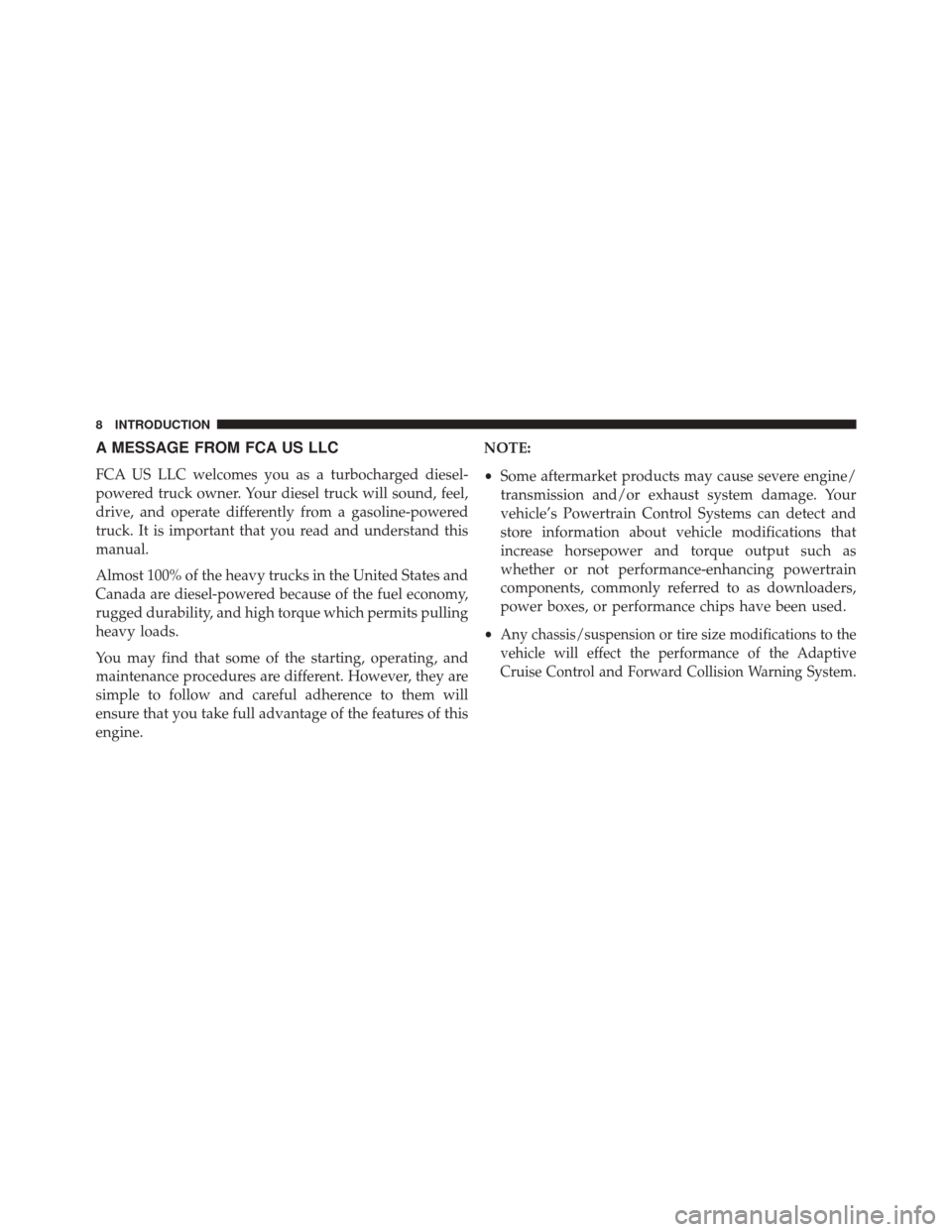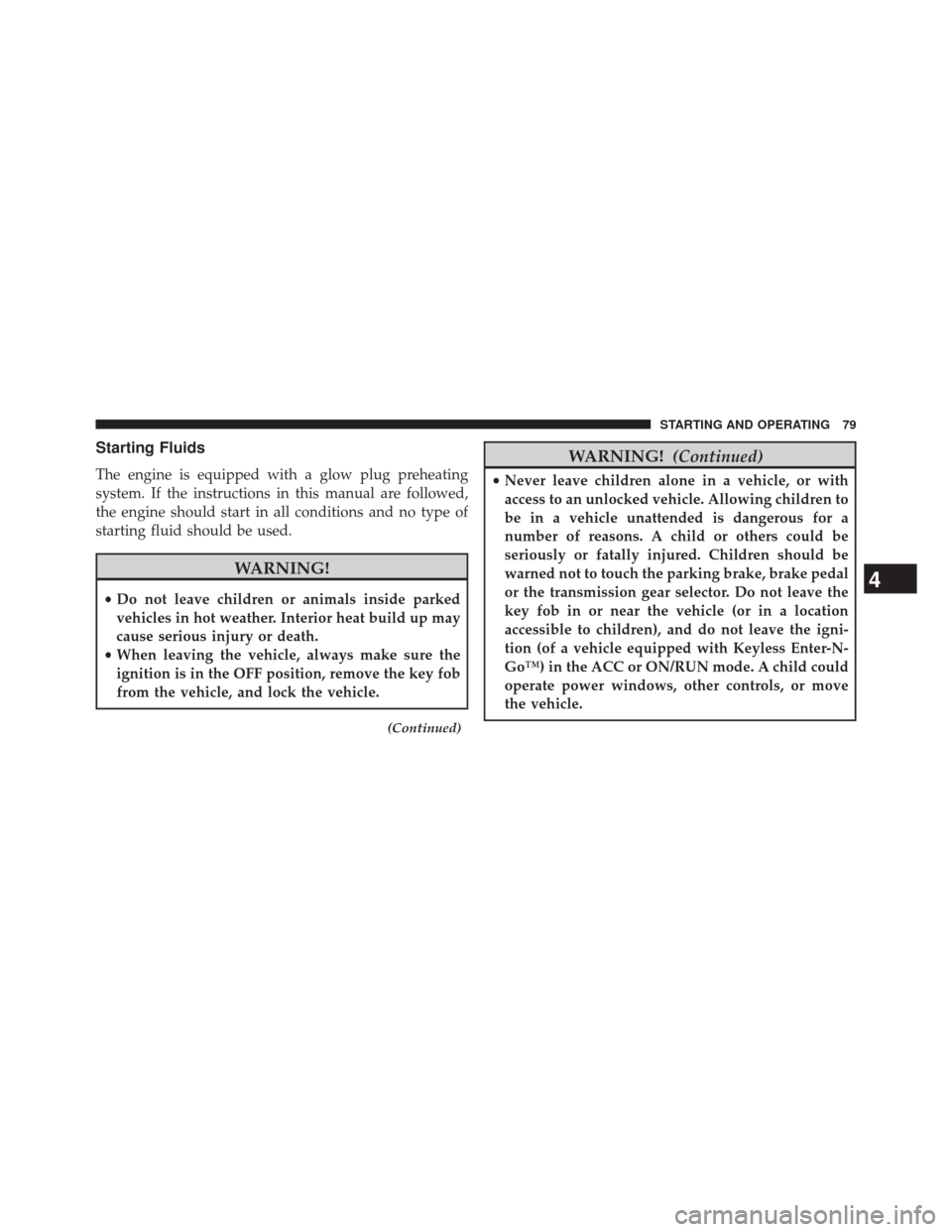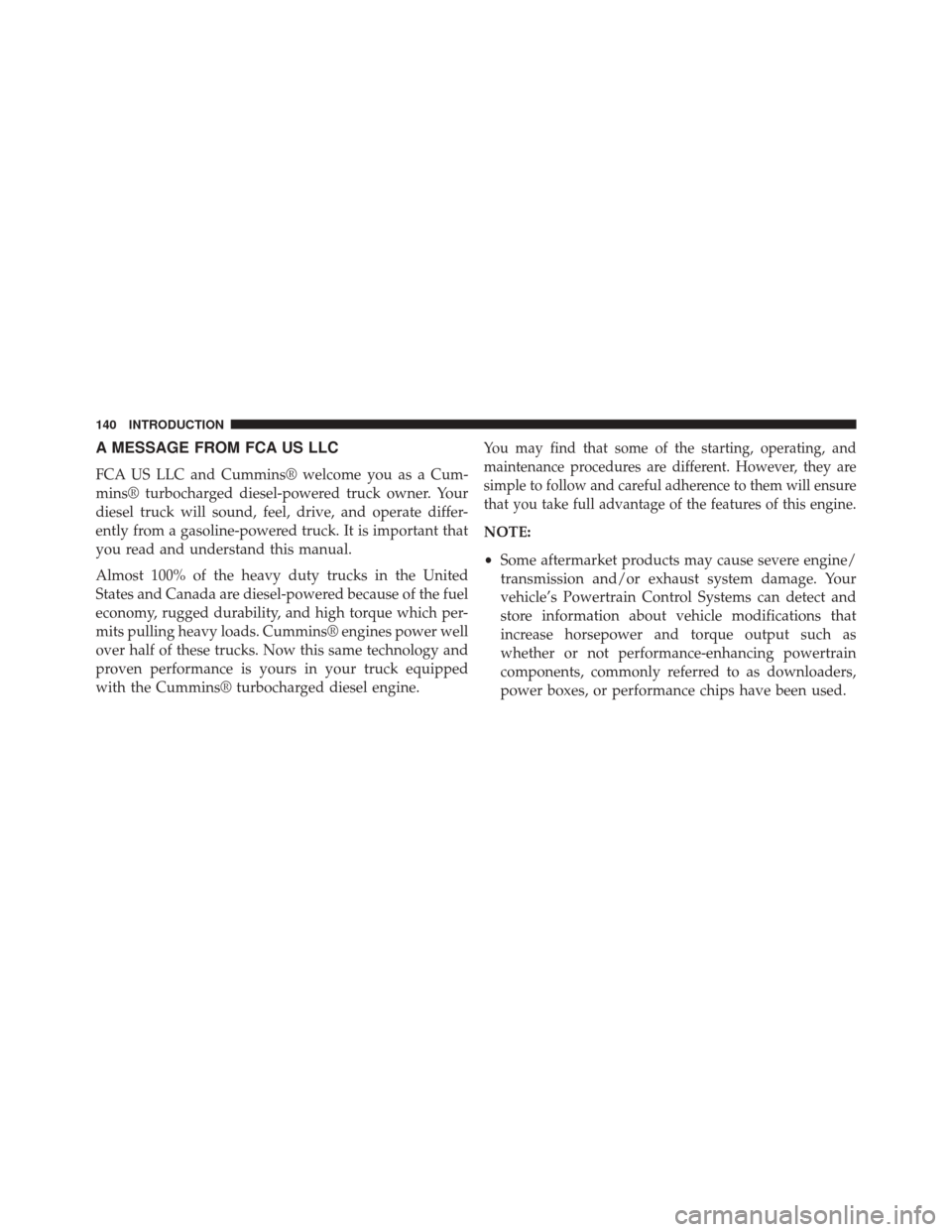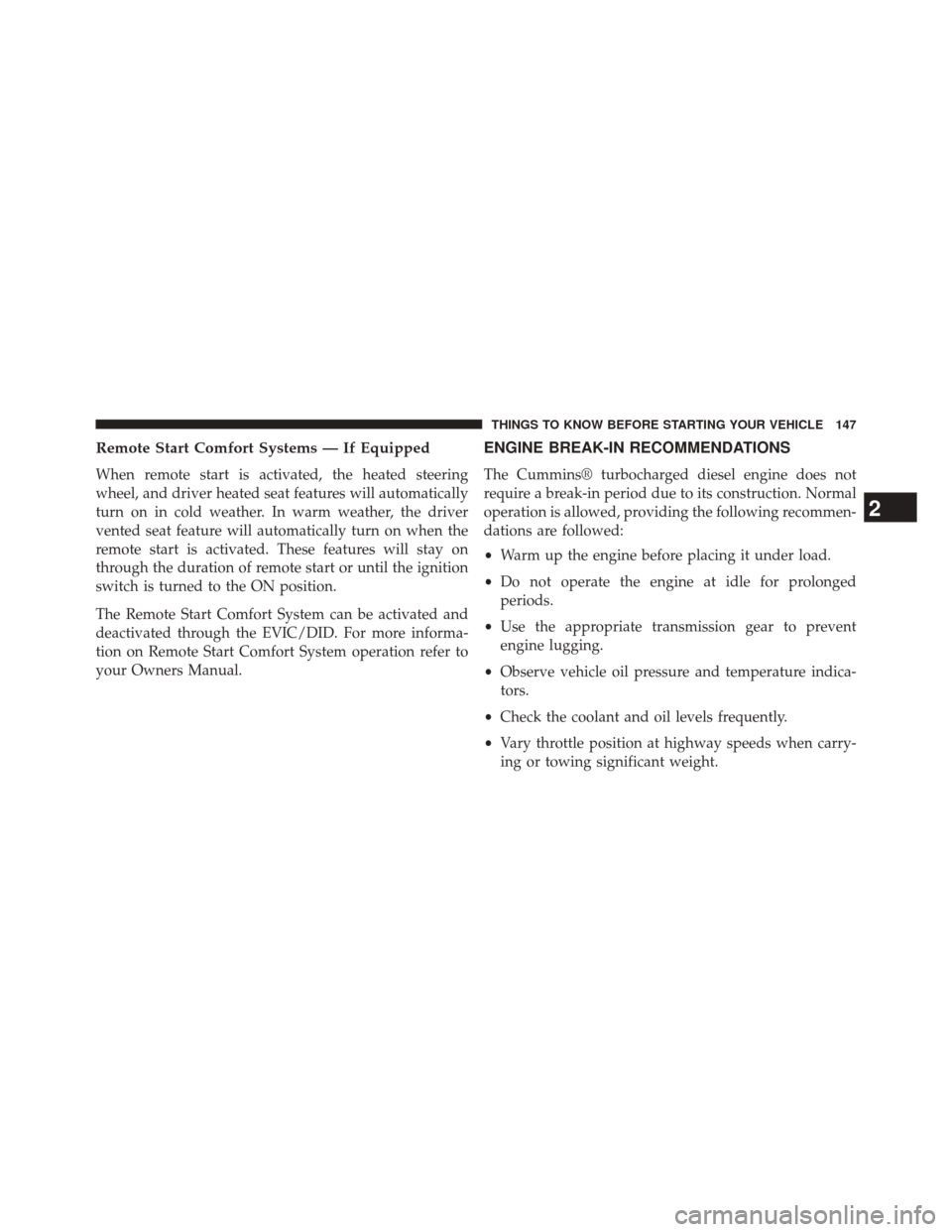Page 10 of 347

A MESSAGE FROM FCA US LLC
FCA US LLC welcomes you as a turbocharged diesel-
powered truck owner. Your diesel truck will sound, feel,
drive, and operate differently from a gasoline-powered
truck. It is important that you read and understand this
manual.
Almost 100% of the heavy trucks in the United States and
Canada are diesel-powered because of the fuel economy,
rugged durability, and high torque which permits pulling
heavy loads.
You may find that some of the starting, operating, and
maintenance procedures are different. However, they are
simple to follow and careful adherence to them will
ensure that you take full advantage of the features of this
engine.NOTE:
•
Some aftermarket products may cause severe engine/
transmission and/or exhaust system damage. Your
vehicle’s Powertrain Control Systems can detect and
store information about vehicle modifications that
increase horsepower and torque output such as
whether or not performance-enhancing powertrain
components, commonly referred to as downloaders,
power boxes, or performance chips have been used.
•
Any chassis/suspension or tire size modifications to the
vehicle will effect the performance of the Adaptive
Cruise Control and Forward Collision Warning System.
8 INTRODUCTION
Page 60 of 347
mounted on the steering wheel. Refer to “Driver Infor-
mation Display– If Equipped” in the Owner’s Manual for
further information.
Driver Information Display (DID) — 7” Display
The Driver Information Display (DID) display is located
in the center portion of the cluster and consists of eight
sections:
1. Main Screen — The inner ring of the display willilluminate in grey under normal conditions, yellow for
non critical warnings, red for critical warnings and
white for on demand information.
2. Audio Information and Submenu Information — Whenever there are submenus available, the position
within the submenus is shown here.
3. Selectable Information (Compass, Temp, Range to Empty, Trip A, Trip B, Average MPG, Trailer Trip
(distance only), Trailer Brake Gain).
4. Air Suspension Status – If Equipped
5. Transmission Gear Position Indicator (PRND)
6. Status Menu Icons
58 UNDERSTANDING YOUR INSTRUMENT PANEL
Page 81 of 347

Starting Fluids
The engine is equipped with a glow plug preheating
system. If the instructions in this manual are followed,
the engine should start in all conditions and no type of
starting fluid should be used.
WARNING!
•Do not leave children or animals inside parked
vehicles in hot weather. Interior heat build up may
cause serious injury or death.
• When leaving the vehicle, always make sure the
ignition is in the OFF position, remove the key fob
from the vehicle, and lock the vehicle.
(Continued)
WARNING! (Continued)
•Never leave children alone in a vehicle, or with
access to an unlocked vehicle. Allowing children to
be in a vehicle unattended is dangerous for a
number of reasons. A child or others could be
seriously or fatally injured. Children should be
warned not to touch the parking brake, brake pedal
or the transmission gear selector. Do not leave the
key fob in or near the vehicle (or in a location
accessible to children), and do not leave the igni-
tion (of a vehicle equipped with Keyless Enter-N-
Go™) in the ACC or ON/RUN mode. A child could
operate power windows, other controls, or move
the vehicle.
4
STARTING AND OPERATING 79
Page 142 of 347

A MESSAGE FROM FCA US LLC
FCA US LLC and Cummins® welcome you as a Cum-
mins® turbocharged diesel-powered truck owner. Your
diesel truck will sound, feel, drive, and operate differ-
ently from a gasoline-powered truck. It is important that
you read and understand this manual.
Almost 100% of the heavy duty trucks in the United
States and Canada are diesel-powered because of the fuel
economy, rugged durability, and high torque which per-
mits pulling heavy loads. Cummins® engines power well
over half of these trucks. Now this same technology and
proven performance is yours in your truck equipped
with the Cummins® turbocharged diesel engine.
You may find that some of the starting, operating, and
maintenance procedures are different. However, they are
simple to follow and careful adherence to them will ensure
that you take full advantage of the features of this engine.
NOTE:
•Some aftermarket products may cause severe engine/
transmission and/or exhaust system damage. Your
vehicle’s Powertrain Control Systems can detect and
store information about vehicle modifications that
increase horsepower and torque output such as
whether or not performance-enhancing powertrain
components, commonly referred to as downloaders,
power boxes, or performance chips have been used.
140 INTRODUCTION
Page 149 of 347

Remote Start Comfort Systems — If Equipped
When remote start is activated, the heated steering
wheel, and driver heated seat features will automatically
turn on in cold weather. In warm weather, the driver
vented seat feature will automatically turn on when the
remote start is activated. These features will stay on
through the duration of remote start or until the ignition
switch is turned to the ON position.
The Remote Start Comfort System can be activated and
deactivated through the EVIC/DID. For more informa-
tion on Remote Start Comfort System operation refer to
your Owners Manual.
ENGINE BREAK-IN RECOMMENDATIONS
The Cummins® turbocharged diesel engine does not
require a break-in period due to its construction. Normal
operation is allowed, providing the following recommen-
dations are followed:
•Warm up the engine before placing it under load.
• Do not operate the engine at idle for prolonged
periods.
• Use the appropriate transmission gear to prevent
engine lugging.
• Observe vehicle oil pressure and temperature indica-
tors.
• Check the coolant and oil levels frequently.
• Vary throttle position at highway speeds when carry-
ing or towing significant weight.
2
THINGS TO KNOW BEFORE STARTING YOUR VEHICLE 147
Page 205 of 347
STARTING AND OPERATING
CONTENTS
�STARTING PROCEDURES ................206
▫ Manual Transmission — If Equipped .......207
▫ Automatic Transmission — If Equipped .....207
▫ Keyless Enter-N-Go™ — If Equipped .......207
▫ Extreme Cold Weather ..................211
▫ Normal Starting Procedure — Engine Manifold
Air Temperature Above 66° F (19° C) ........212
▫ Starting Procedure — Engine Manifold Air
Temperature 0°F To 66°F (–18°C to 19°C) .....213
▫ Starting Procedure — Engine Manifold Air
Temperature Below 0°F (-18°C) ............215▫
Starting Fluids ....................... .217
� NORMAL OPERATION — DIESEL ENGINE . . .218
▫ Cold Weather Precautions ................219
▫ Engine Idling ....................... .221
▫ Stopping The Engine ...................223
▫ Idle Shutdown ....................... .224
▫ Programmable Maximum Vehicle Speed
(Chassis Cab Only) ....................224
▫ Operating Precautions ..................225
4
Page 206 of 347

▫Cooling System Tips — Automatic
Transmission ........................ .225
� ENGINE BLOCK HEATER — IF EQUIPPED . . .227
▫ Block Heater Usage ....................227
� DIESEL EXHAUST BRAKE
(ENGINE BRAKING) ....................227
� AUTOMATIC TRANSMISSION — IF
EQUIPPED .......................... .230
▫ Key Ignition Park Interlock ...............232
▫ Brake/Transmission Shift Interlock System . . .232
▫ Six-Speed Automatic Transmission — If
Equipped .......................... .232
� MANUAL TRANSMISSION — IF EQUIPPED . .244
▫ Shifting ............................ .244▫
Downshifting ....................... .246
▫ Reverse Shifting ..................... .247
� AUXILIARY SWITCHES — IF EQUIPPED .....248
� POWER TAKE OFF OPERATION — IF
EQUIPPED (CHASSIS CAB ONLY) ..........248
▫ Stationary Mode ..................... .249
▫ Mobile Mode ........................ .250
� ENGINE RUNAWAY ....................251
� FUEL REQUIREMENTS ..................252
▫ Fuel Specifications ....................253
▫ Bio-Diesel Fuel Requirements .............254
� ADDING FUEL — 2500/3500 DIESEL
MODELS ........................... .257
� ADDING FUEL — CHASSIS CAB MODELS . . .260
204 STARTING AND OPERATING
Page 209 of 347

Manual Transmission — If Equipped
Apply the parking brake, place the shift lever in NEU-
TRAL and press the clutch pedal to the floor before
starting the vehicle. This vehicle is equipped with a
clutch interlocking ignition system. It will not start unless
the clutch is fully pressed.
Automatic Transmission — If Equipped
Start the engine with the transmission in the NEUTRAL
or PARK position. Apply the brake before shifting to any
driving range.
Tip Start Feature
Do notpress the accelerator. Turn the ignition switch
briefly to the START position and release it. The starter
motor will continue to run but will automatically disen-
gage when the engine is running.
Keyless Enter-N-Go™ — If Equipped
This feature allows the driver to oper-
ate the ignition switch with the push
of a button, as long as the Remote
Start/Keyless Enter-N-Go™ Key Fob
is in the passenger compartment.
Normal Starting
Using The ENGINE START/STOP Button
1. The transmission must be in PARK or NEUTRAL.
2. Press and hold the brake pedal while pressing the ENGINE START/STOP button once.
3. The system takes over and attempts to start the vehicle. If the vehicle fails to start, the starter will
disengage automatically after 10 seconds.
4
STARTING AND OPERATING 207